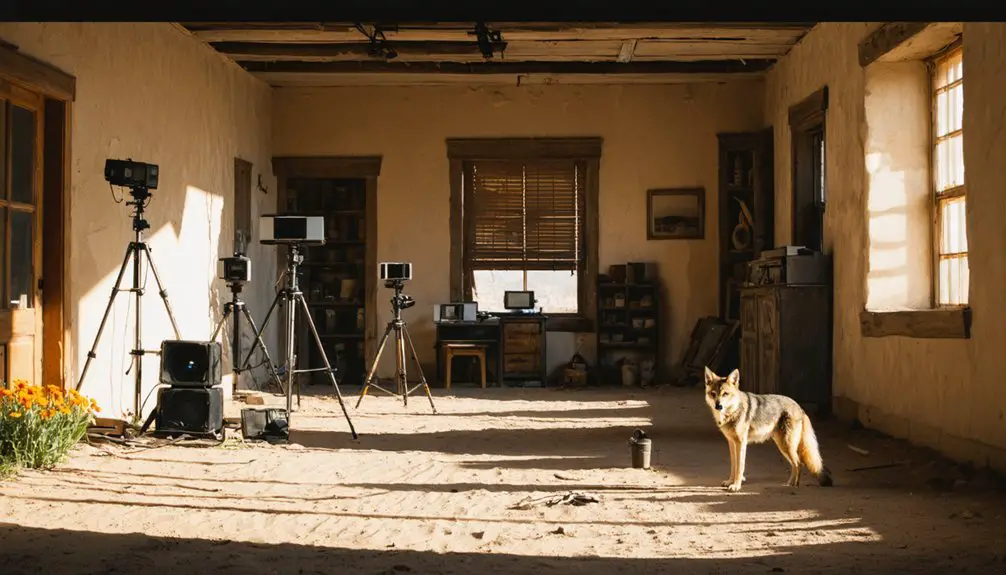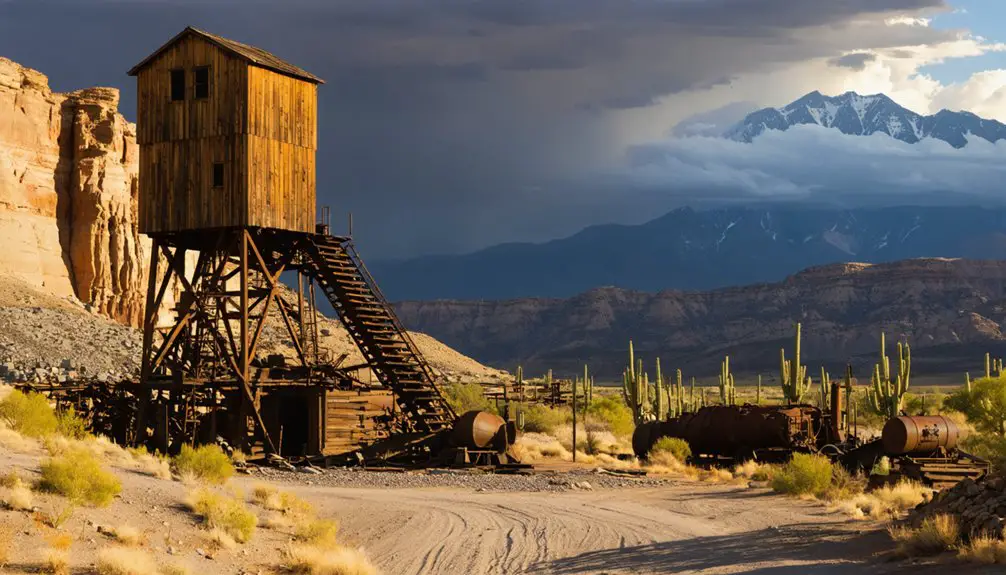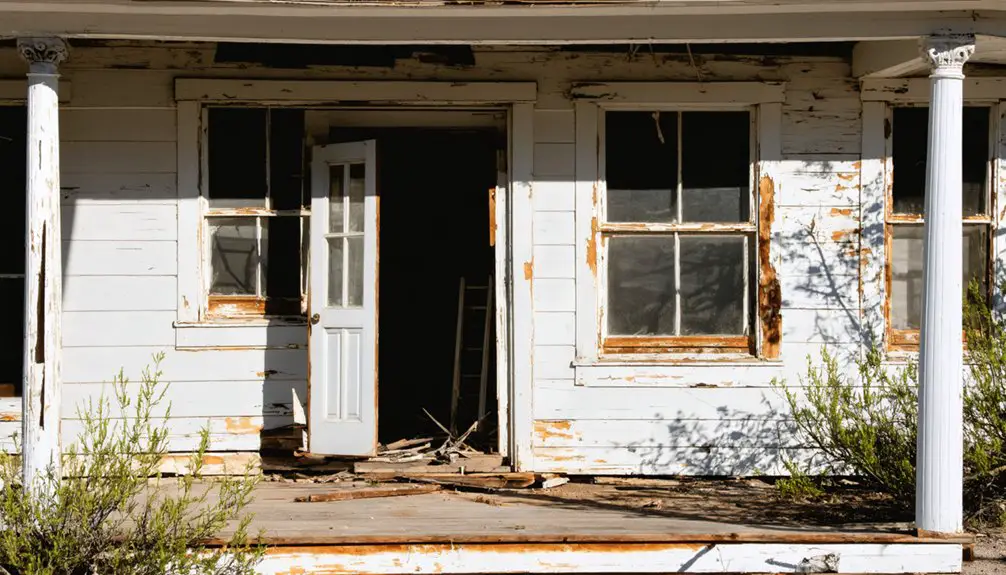You’ll discover Hermosa’s ghost town ruins in Sierra County’s remote Palomas Creek valley, within New Mexico’s Black Range Wilderness. This 19th-century mining settlement, with coordinates 33°09′27″N 107°43′48″W, traces its roots to Spanish colonial mining in 1711. Today, the site enjoys permanent protection through conservation easements, featuring preserved historic structures and mining remnants. The surrounding Gila National Forest‘s 700,000 acres hold countless stories of the American Southwest’s mining heritage.
Key Takeaways
- Hermosa is a ghost town located in Sierra County, New Mexico’s Palomas Creek valley within the Black Range Wilderness.
- The town’s mining heritage dates back to Spanish colonial times, with significant silver production and other minerals like lead and zinc.
- Recent conservation easements established in 2024 protect the ghost town site and Kelsey homestead through the New Mexico Land Conservancy.
- The area lies within Gila National Forest, offering access to extensive wilderness areas and diverse wildlife habitats.
- Historical mining operations, including Spanish colonial workings from 1711-1713, shaped the town’s development before its eventual abandonment.
A Mining Town’s Spanish Legacy
While Hermosa’s heyday as a mining town came later in the 19th century, its mineral heritage traces back to the Spanish colonial period when prospectors first explored New Mexico’s rugged terrain.
Long before Hermosa’s mining boom, Spanish colonial explorers first recognized the mineral riches hidden within New Mexico’s landscape.
You’ll find evidence of Spanish influence in early mine workings dating to 1711-1713, including a covered mine in Sierra de San Lazaro near Hermosa.
Though Spanish mining operations remained small-scale and often unprofitable due to harsh conditions and hostile Native American relations, their cultural impact endured.
Spanish legal systems shaped mining claims, while Spanish terminology and place names became permanent fixtures in the region.
The nearby Santa Rita copper mine, established by 1800, marked a turning point from sporadic prospecting toward sustained mining activity, setting the stage for Hermosa’s future mining heritage.
Location in the Black Range Wilderness
Nestled in the Palomas Creek valley of Sierra County, New Mexico, the ghost town of Hermosa sits at coordinates 33°09′27″N 107°43′48″W within the eastern portion of the Black Range Wilderness.
You’ll find yourself in a remarkably diverse landscape that stretches 55 miles long and 18 miles wide, rising to 10,165 feet at its highest peak.
The Black Range’s ecological diversity surrounds you with distinct habitats as you climb from desert floors through grasslands and pinon-juniper woodlands to mixed conifer forests.
This remote location serves as one of several place name disambiguation sites across New Mexico.
At elevations above 9,000 feet, you’ll encounter spruce and fir trees. The region’s precipitation varies dramatically, from 12 inches in southern woodlands to over 20 inches at higher elevations.
From Hermosa, you can access numerous wilderness trails, including the Spud Patch Trail (#111) that connects to the Continental Divide Trail. Volunteer trail crews regularly maintain these paths to ensure continued public access.
The Natural Curiosity Field Station Today

As a working field station in remote Gila National Forest, Natural Curiosity’s facility now powers its educational programs through solar energy while supporting crucial wilderness research.
You’ll find college students studying field zoology alongside trail crews learning crosscut sawyer techniques, with programs ranging from wilderness first aid to conservation biology. The station’s historic Mercantile building provides modern lecture space for educational programs. A new equine facility is under development to preserve a historic barn while providing public access and supporting local employment.
If you’re heading to the Aldo Leopold or Gila Wilderness areas, the station serves as your gateway to over 700,000 acres of protected land, offering essential support services and expertise for wilderness access.
Educational Programs and Research
Today, the Hermosa Field Station serves as a dynamic educational hub through its Natural Curiosity program, offering unique wilderness and conservation learning experiences.
You’ll find hands-on conservation education opportunities that include wildlife research with Mexican wolves and black bears, backcountry skills training, and specialized wilderness first aid courses.
The station’s 27-mile signature expedition near Aldo Leopold Wilderness lets you test your mettle during a 5-6 day backpacking adventure.
You’ll master essential skills like orienteering, cross-cut sawing, and horse packing while immersed in over 3.3 million acres of national forest.
Through experiential learning programs like Furman University’s Wild Semester, you’ll work alongside professional conservationists and researchers, building practical expertise that translates into real-world conservation careers. The program’s 16-week curriculum combines four intensive courses focused on wildlife conservation in natural settings.
The organization actively promotes eco-tourism activities to support both local economic growth and ongoing conservation initiatives.
Solar-Powered Sustainable Living
The Natural Curiosity Field Station‘s commitment to conservation extends beyond its educational programs into cutting-edge sustainable infrastructure.
You’ll find state-of-the-art solar panel efficiency at work throughout the 54-acre property, powering everything from lodging facilities to research spaces. The 2024 upgrades showcase renewable energy innovations that allow the station to operate completely off-grid in its remote Gila National Forest location. The historic Mercantile building has been transformed into a modern lecture hall while preserving its rustic charm.
The station’s sustainable design includes water-conscious plumbing systems ideal for New Mexico’s semi-arid climate, while solar-powered heating maintains comfort year-round. Hands-on learning experiences help visitors understand these sustainable systems firsthand.
This infrastructure supports extended research stays and educational programs without compromising the surrounding wilderness. Through a conservation easement with the New Mexico Land Conservancy, the historic ghost town site demonstrates how you can blend heritage preservation with modern sustainable living.
Wilderness Access and Support
Situated deep within the Gila National Forest, Hermosa Field Station serves as a strategic gateway to over 700,000 acres of pristine wilderness, including both the Aldo Leopold and Gila Wilderness areas.
You’ll find access via dirt roads from Winston, NM, traveling about 23 miles along St. Cloud Mine Road and Forest Service Road 157. A high-clearance vehicle is recommended for navigating the rocky terrain.
The station’s commitment to wilderness experiences is evident through its $250,000 contract with the Gila National Forest for trail maintenance and restoration.
You’ll benefit from their ongoing work to reopen fire-damaged trails and maintain backcountry access.
The field station provides essential support for trail crews, offering crosscut sawyer training and serving as a base for wilderness programs.
Whether you’re backpacking, orienteering, or seeking wilderness first aid training, you’ll find the resources you need at Hermosa.
Historical Mining Operations and Geology

During its peak in the late 19th century, Hermosa’s mining district emerged as a significant producer within Sierra County’s vast mineral belt, yielding approximately $20 million in ore primarily from silver-rich deposits.
You’ll find evidence of diverse mining techniques throughout the district, from early stamp mills to advanced smelting operations. The Hearst estate pioneered deep excavation methods, reaching depths of 400 feet using mechanized mineral extraction.
The district’s geology features complex Paleozoic formations along the eastern flank of the Black Range and Mimbres Mountains. The unique Pz geologic unit significantly influenced mining development and mineral deposits in the region.
While silver dominated production, you’ll discover the area yielded valuable deposits of lead, zinc, copper, and fluorspar.
Though ASARCO modernized operations through the 1960s, today only South32 Hermosa continues exploration on private lands, with no active mining operations remaining.
Conservation Efforts and Protected Lands
Through conservation easements established in 2024, you’ll find permanent protection for both the 54-acre Hermosa ghost town site and the 40-acre Kelsey homestead property.
These agreements with the New Mexico Land Conservancy guarantee land preservation by restricting development while maintaining the area’s natural and historic character.
You’ll discover Hermosa’s strategic location within the Gila National Forest provides access to over 700,000 acres of wilderness, including the adjacent Aldo Leopold Wilderness.
The protected lands support diverse wildlife, from Yellow-breasted Chats in the riparian cottonwoods to Montezuma Quail in desert scrub habitats.
From vibrant chats among riverside trees to quail darting through desert scrub, these lands pulse with wild diversity.
Natural Curiosity’s field station, renovated in 2023, now serves as a hub for habitat restoration efforts, research, and educational programs that demonstrate the importance of wilderness conservation while maintaining the site’s rugged, authentic character.
Research and Educational Opportunities
Since Natural Curiosity’s 2023 acquisition of Hermosa ghost town, you’ll find extensive research and educational possibilities at the newly established field station.
You can conduct archaeological studies of 19th-century structures, including the mercantile, hotel ruins, and cemetery, while exploring frontier settlement patterns and mining camp dynamics.
The site’s location adjacent to Aldo Leopold Wilderness enables environmental assessments across diverse ecosystems.
You’ll encounter research opportunities studying wildlife like Montezuma Quail, Yellow-breasted Chats, elk, and javelina in habitats ranging from riparian cottonwoods to mixed coniferous forests.
The field station’s renovated facilities support hands-on learning experiences for students and researchers, with programming that integrates local ecology, geology, and mining history into cross-disciplinary education.
Frequently Asked Questions
What Was the Maximum Population of Hermosa During Its Peak Mining Years?
While mining history often gets overstated, you’ll find reliable records showing the peak population reached 400 residents in 1880 before population decline set in as silver processing and smelting operations diminished.
Are There Any Dangerous Abandoned Mine Shafts Visitors Should Avoid?
You’ll find numerous unstable mine shafts throughout the area. For your safety, don’t enter any openings – they’re on private property and pose serious risks of collapse, toxic gases, and flooding.
Can Visitors Stay Overnight at the Field Station Without Research Purposes?
Like a welcoming mountain retreat, you can stay overnight at the field station. While research isn’t required, you’ll need to contact them about visitor guidelines and available accommodations at 575-322-1221 or via email.
What Wildlife Species Are Commonly Spotted Around the Ghost Town?
You’ll spot diverse wildlife encounters around the ghost town, including mule deer, coyotes, black bears, mountain lions, red-tailed hawks, western scrub-jays, lizards, and various butterflies in this rich ghost town ecology.
When Did the Last Permanent Residents Leave the Town of Hermosa?
While ghost town legends suggest earlier departures, historical significance points to 1929’s post office closure as your best indicator of when the last permanent residents left, though some ranching families lingered afterward.
References
- https://www.natural-curiosity.org/hermosa
- https://www.ghosttowns.com/states/nm/hermosa.html
- https://en.wikipedia.org/wiki/List_of_ghost_towns_in_New_Mexico
- http://blackrange.org/the-human-history-of-the/mining/the-mines-of-the-black/the-hermosa-mining-district/
- https://www.southernnewmexicogivingday.org/organizations/natural-curiosity
- https://agmc.info/wp-content/uploads/simple-file-list/New-Mexico-documents/New_Mexico_Mining_History.pdf
- https://upload.wikimedia.org/wikipedia/commons/e/e3/New_Mexico_mines_and_minerals_…_Being_an_epitome_of_the_early_mining_history_and_resources_of_New_Mexican_mines
- https://south32hermosa.com/wp-content/uploads/2022/11/Patagonia-Mining-History.pdf
- https://pubs.usgs.gov/bul/1876/report.pdf
- https://en.wikipedia.org/wiki/Hermosa



